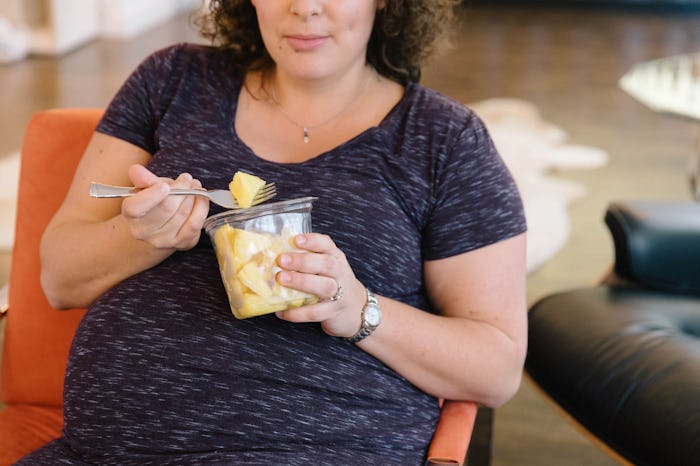Life
If You Want To Try Inducing Labor At Home, Here's What You Should Know
When you near the end of your pregnancy, with no signs of labor in sight, it's only normal to begin looking for natural ways to induce labor. The aches and pains of pregnancy, the anxiety of labor, and the anticipation to finally meet your baby really make pregnant moms want to get things moving. But when can you start trying to induce labor? You're probably in a rush to get things going, but you want to be safe, too.
Romper spoke to Dr. Kenneth James, OB-GYN from Saddleback Memorial Medical Center, who says that pregnant moms should wait until their 39th week of pregnancy before they try self induction because of health and safety issues with the baby. “The standards of care recommend inducing between 41 to 42 weeks of gestation for a low risk, uneventful pregnancy," James says. He suggests waiting until the last minute for a medical labor induction, because the best outcomes come to those who enter labor spontaneously.
In fact, most doctors recommend you wait because up until 39 weeks, your baby is still going through crucial developments. Dr. Yen Tran, OB-GYN at Orange Coast Memorial Medical Center, tells Romper that she won’t medically induce a healthy pregnancy until after 41 weeks. “Studies show the majority of fetal brain development occurs between 36 to 39 weeks," explains Tran, “so we do try to keep patients pregnant until 39 weeks.”
Still anxious to get started? There are some important things to note. Dr. Adrienne D. Zertuche, OB-GYN at Atlanta Women's Healthcare Specialists, tells Romper in an interview that in general, induction should only be done for a medical reason or if you have gone past your due date by one to two weeks, and typically, inductions are done in the hospital setting where your baby, contractions, and cervical change can be closely monitored. She adds that it's actually unsafe to try at home induction methods without getting a green light from your doctor. “However,” adds Zertuche, “if you have had a low-risk and straightforward pregnancy, your obstetrician may be open to you trying to start the process at home." When? 39 weeks, of course.
Once you have reached week 39 (it's truly the magic number), if you and your obstetrician feel it’s okay to get the ball rolling, there are some methods that you can try to self induce. “Herbal supplements, certain citrus fruits, and dates have been known to induce labor,” according to James, “along with massage therapy, foot reflexology, and acupuncture, but avoid any supplements that cause diarrhea.”
You can even try a little romp session with your partner. “If patients want to do something to induce their labor at home,” suggests Tran, “they could have more frequent intercourse in a way that semen could stay inside the vaginal area to ripen the cervix.” She adds that you can use a breast pump or try just simple nipple stimulation, along with using essential oils to massage your perineum. Tran also suggests applying a warm towel on your perineum at night to soften the area to prevent vaginal tearing during delivery.
So while you may be in a rush to get that baby out, it’s best to wait until you hit week 39 and make sure you keep your doctor in the loop. Luckily pregnancies don’t last forever, and before you know it, you’ll be holding your beautiful baby in your arms.
